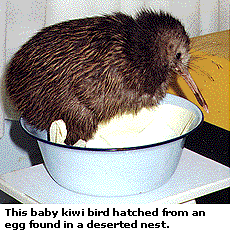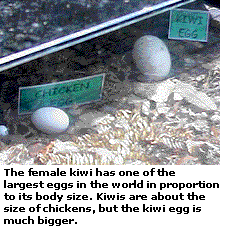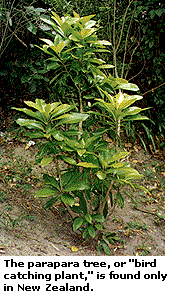 |
My Encounters With Unique Wildlife |
 |
|||
| What a trek this has been! I've walked over 1,000 miles, and have about 450 miles to go. I've seen so many amazing things along the way, including some very interesting animals and plants.
Tuatara: Ancient Reptiles Tuataras are reptiles, with scaly skin and shelled eggs that enable them to breed and live on land. But they are different from modern lizards in several ways. First, tuatara teeth are just sharp indentations of their jaw bone, with two rows on the upper jaw and one row on the lower jaw. Second, the bones of a tuatara's spine are hollow — similar to a fish's. Third, the tuatara's skull is like the dinosaur's, with more holes than modern-day lizards. Finally, light-sensitive cells are found on top of the tuatara's head — remnants of a primitive third eye. It is believed that these reptiles have hardly changed their external shape in 140 million years. (Scientists have found fossils of an ancient reptile called Homeosaurus that look very much like tuataras, which date back this far.) Tuataras are found only in New Zealand, but their existence is threatened. In other places, reptiles like the tuatara became extinct because their eggs and their young were eaten by mammals such as rats. These mammals also ate much of the same food as the reptiles — insects, lizards, frogs, birds' eggs — and competed with the reptiles for food. The tuataras were able to survive in New Zealand because the only mammals present were small bats that flew there from other islands. Some birds, like the harrier hawk and kingfisher, preyed on the tuataras, but the ancient lizards managed to survive. But when people came to New Zealand they brought rats with them and tuataras began to disappear on the mainland. Today, tuataras only live on offshore islands where there are no rats. At the Auckland Zoo and other zoos in New Zealand, tuataras are being bred in captivity and released back onto islands to help increase their numbers.
Kiwi: Flightless Birds This particular kiwi had been hatched in an incubator at the Auckland Zoo, its egg taken from the wild. The newly born kiwi had been fed insects, worms, and corn until it was six months old, then released back into the same place where its egg had been laid. Like the tuataras, kiwi birds are bred in captivity so they have a chance of surviving in areas with dangerous predators. In the wild, 19 of 20 kiwis die before they reach one year old because they are attacked by predators like stoats, ferrets, and dogs. Kiwi birds are found only in New Zealand, and are a national symbol. The birds are unusual in several ways: First, they have tiny wings, but do not fly. They are distantly related to other flightless birds, like ostriches. Second, kiwis are the only birds with nostrils at the end of their beaks. (They use their keen sense of smell to find insects and worms in undergrowth as they forage at night.) Third, kiwis have whiskers on either side of their beaks, which help them judge the width of spaces they can squeeze through. Fourth, the feathers of a kiwi are very fine, and feel more like hair than other birds' feathers. And finally, the female kiwi has one of the largest eggs in the world (in proportion to its body size).
Parapara: Bird-Catching Plants The parapara is a peculiar plant only found here in New Zealand, and like the kiwi bird and the tuatara, it is becoming quite rare now. There are 2,500 plants that are only found in this country and about 250 of those are now in danger of becoming extinct. On a journey through New Zealand you become aware of how unique the wildlife is here, but also how the introduction of species from other countries has threatened the unusual plants and animals. |

|
||||
|
|||||



